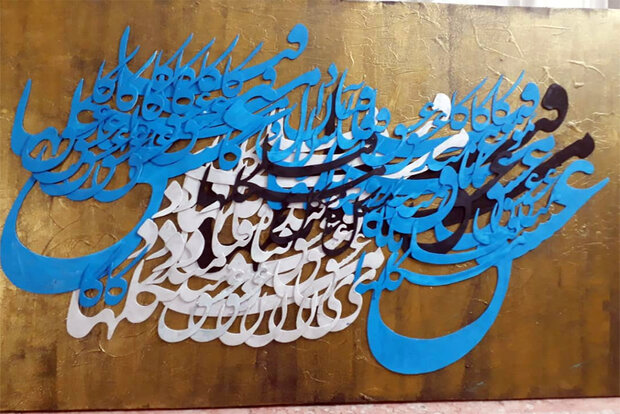
An Iranian calligrapher, Majid Khandagh Abadi, believes that one of the reasons the Persian calligram has become so popular in the last forty years is because the art style is looking to find an audience outside the country.
Persian calligram is a modern art style made up of a combination of calligraphy with painting and graphics. In the composition of calligram artworks, letters and words are arranged in such unique and aesthetic ways that it becomes almost impossible to distinguish between them.
Iranian calligrapher Majid Khandagh Abadi, whose calligram exhibition ‘Asheghaneh’ (‘Romantic’) is on display at Khavaran art gallery until Monday, told Mehr correspondent that his exhibition includes 35 calligram artworks, all inspired by the romantic poetry of Persian poets and mystics, mostly Rumi, Hafiz, and Sa’adi.
Noting that he has used acrylic and gold sheet in creating the artworks, Khandagh Abadi explained about the calligraphy used in the works, called ‘Nasta'liq’: “I tried to make sure that no harm was done to the characteristics of the letters and the combination of the Nasta'liq – an issue that is currently challenging calligram. Some fellow artists change the characteristics of the letters, probably to make it more beautiful, and for sure there is an artistic justification for it, but I, personally, decided to make no changes to the form of Nasta'liq.”
Talking about the limitations and potentials of calligram these days, he said “For starters, I think there shouldn’t be any boundaries when it comes to the art of calligram; that is, we shouldn’t try to put down a line and say an artwork is only a calligram up to this line and it no longer is a calligram over the line. Another point is related to the audience’s taste. At the moment, the audience may not take too well to the old style and texture of Nasta'liq, because the script has been used for centuries and may no longer appeal to the taste of the modern audience.”
“The third point is related to the artist’s skill. I talk about myself: for example, my skill is limited to the creation of my own works and I don’t have the courage to change anything about Nasta'liq letters and combinations; but of course, many of my fellow artists do that and some of them manage to create very beautiful works of art.”
“I think that the audience and the artist’s skills are the deciding factors for choosing a particular style over the others,” he added.
At the end, the artist talked about the potential of Persian calligram for becoming international: “The truth is that I have not yet had a chance to hold an exhibition overseas, but it is only natural that when painting techniques take over the calligram techniques, it would probably appeal more to the international audience, since calligraphy alone cannot attract the audience from other countries.”
“Perhaps, one of the reasons that Persian calligram has become so popular in the last forty years was because of the attempts to make the art more accessible to people across the world, especially because Nasta'liq is a completely Iranian script and a foreign audience would not understand it,” Khandagh Abadi added.
Source: Mehr News Agency

Add new comment